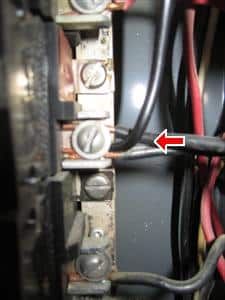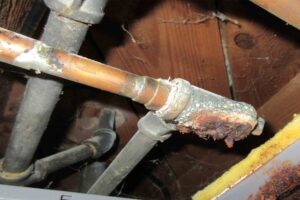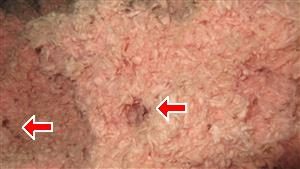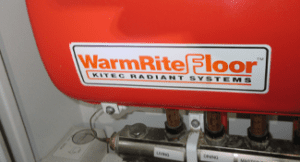Common Home Inspection Defects
Electrical Double Taps
A Common Home Inspection Defect is a double tap in an electrical panel which refers to added wires at breaker connections to increase the number of circuits that are available to the electrical system. This practice is not permitted by most manufactures. The Double Tap is accomplished by connecting two  conductors (electrical cables) to one terminal of a circuit breaker, and or two neutral conductors under one screw at the neutral bar. Cutler Hammer and Square D both make a circuit breaker on which it is permitted to attach two connectors, these types of circuit breaker are clearly identified on their labels. The best solution to this problem is to have a licensed electrician install another circuit breaker and remove the double tap connection. View Electrical Defect Pictures from actual home inspections.
conductors (electrical cables) to one terminal of a circuit breaker, and or two neutral conductors under one screw at the neutral bar. Cutler Hammer and Square D both make a circuit breaker on which it is permitted to attach two connectors, these types of circuit breaker are clearly identified on their labels. The best solution to this problem is to have a licensed electrician install another circuit breaker and remove the double tap connection. View Electrical Defect Pictures from actual home inspections.
Roof Inspections
Every home has a roof which may be constructed out of many products. Inspecting your roof is an important part of your home inspection. Typically roof shingles are made of fiberglass and have a life expectancy of approximately 15 years. Read more about Roof Inspections
Vermiculite Insulation
Asbestos insulation is a Common Home Inspection Defect found in many older homes have had vermiculite insulation added to their existing insulation. The vermiculite insulation that originated from Libby Montana was found to have traces of asbestos when tested. The only way to determine if vermiculite has asbestos is by sending samples to a lab for testing. Having vermiculite insulation removed can cost a home owner of an average house between 8 and 15 thousand dollars. Having your home properly inspected can prevent you from having an expensive asbestos removal bill after taking possession of your new home.
Window Sill Mortar Cracks
This is one of the most defects found during a home inspection, concrete split window sills with cracked or missing mortar. On newer homes the builder will typically put caulking over the mortar seam between two pieces of concrete sill. Over time the caulking shrinks and allows water and moisture to start attacking the mortar seam. Once the mortar is cracked the natural thawing and freezing action in winter starts to break up the mortar and the moisture proceeds down to the brick below the sill. Even on fairly newer homes it is common to see the brick mortar under a window sill starting to crack, and in some cases the moisture causes damage to the brick by spalling. Spalling is when the brick (typically clay brick) absorbs moisture and then freezes, the freezing action causes the moisture to expand, blowing of part of the brick finish.
Chimney Caps
New homes have to have a one piece cap installed, no more mortar chimney caps which usually have many gaps and cracks. The requirements for a chimney cap are to be one piece and they must have a drip edge installed. The top of the cap is required to slope away from the liner. Jointed precast chimney caps are also required to have flashing installed extending from liner to the drip edge. A bond break is required between liner and cap which is comprised of a non-bonding sealant that can expand and contract with the liner. Older caps usually had two piece caps which were then sealed with mortar. Unfortunately the mortar tends to easily crack and allow water to penetrate. Failing to keep the chimney properly sealed can lead to damage to flue tile and eventual repair of some or all of the flue liner. Most people opt to insert a stainless steel chimney liner when water damage has affected their clay flue tiles.
Galvanized Plumbing Issues
Most homes that have Galvanized Plumbing were built around the 1950’s which is approximately 70 plus years ago. The life expectancy for Galvanized Plumbing is between 40 to 50 years. Unfortunately galvanized plumbing
 deteriorates from the inside out, which make imminent failure difficult to determine. Many insurance companies will not insure a home with galvanized plumbing. Some older homes may have copper or pex plumbing lines at fixtures but may have galvanized pipe still installed in hard to access areas. In this inspection picture you can see that the galvanized runs up and also along floor joist area. The vertical pipes would probably be for bathtub supply which are buried in the wall. A lot of demolition and repairs will be required to remove this small area of galvanized pipe.
deteriorates from the inside out, which make imminent failure difficult to determine. Many insurance companies will not insure a home with galvanized plumbing. Some older homes may have copper or pex plumbing lines at fixtures but may have galvanized pipe still installed in hard to access areas. In this inspection picture you can see that the galvanized runs up and also along floor joist area. The vertical pipes would probably be for bathtub supply which are buried in the wall. A lot of demolition and repairs will be required to remove this small area of galvanized pipe.
Leaking Thermal Seals
This is a Common Home Inspection Defect in windows which are becoming more common in subdivision homes. Energy saving windows and doors have thermal sealed glass units installed which provide an air gap for insulation. Signs of a leaking seal are foggy or moisture droplets on the inside portion of the thermal unit. Most window units leak from the bottom section of the window where the support blocks are located. Cheaper builders grade windows have smaller and less support which can lead to a puncture of the sealant material causing the leak. Some people, usually sellers, will call in a company to drill holes in exterior glass unit and then clean the window interior with alcohol type product which will easily evaporate or be absorbed by the desiccant material most windows have in the bottom section. This is not a great fix as you lose your thermal seal and you might as well just break the outer glass and remove it and save yourself some money. The recommended way to repair a leaking thermal seal unit would be to remove the glass unit, slider or casement etc., and take it to a local glass repair shop. Some companies will repair the existing thermal unit while others will replace unit with a new one.
Attic Insulation
One common home inspection defect is the presence of mice in the attic. Telling potential home buyers that there is rodent trails in their attic insulation is not a pleasant experience. Women are especially concerned about the thoughts of sharing their home with mice. Unfortunately almost 95% of brick homes  that have fiberglass insulation will have mice running around in their attic. Mice can walk up a brick wall as easily as we walk on a sidewalk. They can also compress their heads allowing them to access the attic through any small hole or crack. Vinyl clad homes do not have this problem as mice are unable to climb on the vinyl material. Cellulose insulation, which is re-cycled paper treated with fire retardant chemicals, does not attract mice and when an attic is inspected there is no visible signs of rodents in the insulation. My solution on my own home was to blow in approximately 6 inches of cellulose insulation over the existing fiberglass. I have not seen a mouse since then but I would not guarantee that there was no mice living under the cellulose in the existing fiberglass insulation. Rodent trails have also been found during inspections in attics with Roxul and Rock Wool insulation types.
that have fiberglass insulation will have mice running around in their attic. Mice can walk up a brick wall as easily as we walk on a sidewalk. They can also compress their heads allowing them to access the attic through any small hole or crack. Vinyl clad homes do not have this problem as mice are unable to climb on the vinyl material. Cellulose insulation, which is re-cycled paper treated with fire retardant chemicals, does not attract mice and when an attic is inspected there is no visible signs of rodents in the insulation. My solution on my own home was to blow in approximately 6 inches of cellulose insulation over the existing fiberglass. I have not seen a mouse since then but I would not guarantee that there was no mice living under the cellulose in the existing fiberglass insulation. Rodent trails have also been found during inspections in attics with Roxul and Rock Wool insulation types.
Reversed Polarity
Many times when a home owner has done their own renovation of a basement there are a lot of electrical outlets with reversed polarity or open grounds. This creates an immediate problem which has to be explained to the potential home buyer. When the electrical work was not done properly it indicates that there was not permit taken out for the work and it was never inspected or passed by the approving electrical authority. If this was found in a renovated basement then it usually is a safe bet that there was never any permits taken out for any work including plumbing and framing etc. When buying properties for myself I always assume that if there are visible defects in workmanship found then there will be others that are hidden by drywall, paneling and ceilings. A buyer has to weight the benefits of ignoring the fact that there was no permits or inspections performed against the possible liabilities. Read about our Electrical Inspections
Foundation Cracks
Another Common Home Inspection Defect is foundation cracks in concrete. Poured concrete is not flexible and most homes will settle within the first five years causing settlement cracks in concrete. Typically these cracks are vertical and are hardly noticeable. Horizontal cracks in your foundation, especially if sideways movement has occurred, should be investigated by a Structural Engineer. Tarion Warranty is only for One-Year and includes Work and Materials. · This is for Cracks resulting from normal shrinkage of materials caused by drying after construction are excluded from the statutory warranty. Tarion will repair cracks in foundation is there is water penetrating the foundation wall. Read more about foundation cracks and Structural Defects.
Kitec Plumbing
Kitec plumbing pipes may not just LEAK but will BURST causing a potential flood in the home. When the water temperature becomes hotter than the manufacturer’s rating of 77ºC (180ºF) or by excessive water pressure, it causes the Kitec pipes to deteriorate. Tests have shown that the plastic and aluminum in the Kitec pipe expands and contracts at different temperatures. Over time this can cause leaks or bursts, floods and damage. It’s only a matter of time before they fail. The only fix for Kitec Plumbing is to replace it. 2019 was last year for lawsuit settlement payments.
The above deficiencies highlight the reason that a home buyer should have a Home Inspection. Read article on why a Home Inspection is Necessary.
Home Maintenance Tips for Home Owners
Valuable resource for Home Owners interested in Preventive Maintenance tasks they can do around the home to prevent expensive repairs later. These are mainly simple tasks which will take little time and hardly any effort and will guarantee your home stays in Tip Top Condition. Also check out our Frequently Asked Questions Page for answers to your questions.
The Value of a Home Inspection
Hiring a Professional Home Inspector prior to purchasing a property can potentially save you thousands of dollars in needless repair bills. Todays Home Buyer has little of no protection from unscrupulous sellers who may know or have tried to hide defects which may affect the value of the property. Your Realtor is obligated by law to inform you of any deficiencies they maybe aware of. This information would have to be revealed by home owner or listing Realtor which may or may not happen. Caveat Emptor – Buyer Beware is the basis for Buyer Protection in Ontario. So when you purchase a property in Ontario the Home Inspector is the only one on the hook for providing you with pertinent information on the home you are buying. Considering the average price of a home in my area is over $800,000.00 it always amazes me that a prospective buyer is more concerned with the price rather than asking about my training, experience and knowledge.
A case in point: I inspected the same house twice within the same calendar year. The reason it did not sell the first time was due to both main and upper floor was heated by Kitec water lines. Kitec plumbing will fail and cause significant damage at some time in the future and is well known by Home Inspectors and Realtors. The seller and Listing Agent both knew that the reason the first Offer to Purchase fell through was due to the presence of Kitec Plumbing. The second purchaser had no idea that the home had such a major defect, even though Kitec Identification Label was clearly visible on boiler and stamped on Plumbing Lines. The seller should have legally disclosed the presence of Kitec Plumbing and any experienced Realtor should have noticed such an obvious defect, but at the end of the day it all depended on the Home Inspector making the buyer aware of presence of a potentially expensive plumbing replacment.
significant damage at some time in the future and is well known by Home Inspectors and Realtors. The seller and Listing Agent both knew that the reason the first Offer to Purchase fell through was due to the presence of Kitec Plumbing. The second purchaser had no idea that the home had such a major defect, even though Kitec Identification Label was clearly visible on boiler and stamped on Plumbing Lines. The seller should have legally disclosed the presence of Kitec Plumbing and any experienced Realtor should have noticed such an obvious defect, but at the end of the day it all depended on the Home Inspector making the buyer aware of presence of a potentially expensive plumbing replacment.
Note: The picture on right shows how visible the Kitec Plumbing Label was. ( typically Kitec Plumbing lines are a unique colour which allows for easy idenification )
We also provide Home and WETT inspections to Wasaga Beach.
Inspection Areas
Alliston
Angus
Barrie
Innisfil
Orillia
Midland
Penetanguishene
Newmarket
Wasaga Beach
Certifications



